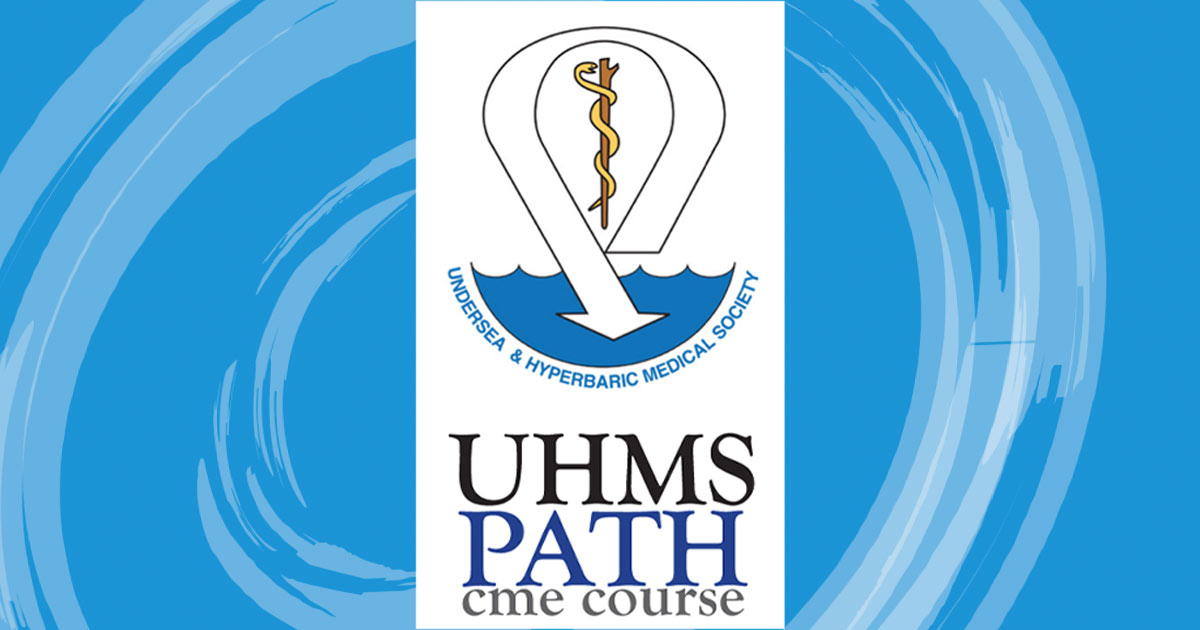UHMS Program for Advanced Training in Hyperbaric Medicine
Enoch Huang, MD, MPH&TH, FACEP, FACCWS

Taking a new PATH
UHMS Program for Advanced Training in Hyperbaric Medicine
The Undersea and Hyperbaric Medical Society has been developing a new way for medical professionals to learn about undersea and hyperbaric medicine (UHM). It’s called PATH, the Program for
Advanced Training in Hyperbaric Medicine.
Generally there has been a low bar to practice undersea and hyperbaric medicine. Most hospitals only require completion of a 40-hour introductory course in hyperbaric medicine (ICHM) to get hospital privileges. Some organizations are offering portions of the ICHM online, circumventing the UHMS requirement that those 40 hours be conducted in person with live, face-to-face encounters with course faculty.
On the other end of the spectrum the UHMS considers UHM fellowship training and American Board of Medical Specialties (ABMS) UHM board certification to be the gold standard when considering education in hyperbaric medicine. We recommend this pathway for all new graduates and anyone who has the means to do so.
However, we recognize that not every current practitioner can take a year away from work to complete this process. This is where the PATH comes into play. This extensive online program allows individuals to earn recognition for the extra effort they have put into obtaining advanced education in hyperbaric medicine. Physicians (MDs/DOs) are able to earn a Certificate of Added Qualification (CAQ), and Advanced Practice Clinicians (NPs/PAs) can earn a Certificate of Advanced Education (CAE), demonstrating that they have gone above and beyond the minimum 40-hour ICHM.
While other organizations offer a CAQ in hyperbaric medicine, the UHMS CAQ is different: The requirements are much more stringent and involve both didactic material as well as a peer-reviewed clinical management component as part of the PATH. Additionally, the UHMS PATH will be the first program to include Advanced Practice Clinicians (APCs), who will be able to earn a Certificate of Advanced Education. While the issue of whether APCs should be allowed to supervise hyperbaric oxygen (HBO2) treatment or not is still actively debated, this is an issue that is outside the control of the UHMS and is regulated by the laws of individual states. The UHMS Board of Directors voted to embrace our mission of education and raise the level of education for all providers of HBO2.
Students in PATH can earn more than 100 hours of CME reviewing a carefully curated syllabus of pertinent hyperbaric literature and video lectures. The previously proposed case submissions and case conferences are being replaced with new modules that assess candidates’ abilities for critical thinking and medical decision-making in hyperbaric-specific case scenarios.
Finally, students must complete an in-person hands-on skills lab to demonstrate familiarity with chamber systems and treatment algorithms. Beyond demonstrating technical skills in airway management and procedures, this course will leverage simulation lab technology to teach and assess candidates’ abilities to manage emergency situations in the hyperbaric environment.
This program is far and above what is available through other certification programs, which usually include only a written examination and a self-reported “log” of supervised treatments. Completion of the UHMS PATH will prepare the student to be a safer, smarter, and superior hyperbaric practitioner.
Components of the PATH includes these learning blocks.
Block 1: Hyperbaric physiology and side effects
Block 2: Carbon monoxide poisoning
Block 3: Chronic radiation tissue injury
Block 4: Arterial insufficiencies, CRAO, ISSHL, crush injury
Block 5: Problem wounds, diabetic ulcers, chronic osteomyelitis
Block 6: Intracranial abscess, acute blood loss anemia, thermal burns
Block 7: Necrotizing soft tissue infections and critical care
Block 8: Decompression illness
Block 9: Investigational uses of HBO2
Here’s a summary of other aspects you will want to know.
- PATH is not a substitute for ABMS board certification in UHM, and its curriculum is certainly not a substitute for fellowship training, which is considered the gold standard for physician education in UHM.
- There is a large knowledge gap between completion of a 40-hour ICHM and fellowship training.
- The knowledge gained in a 40-hour ICHM is insufficient to fully prepare a clinician to practice the full breadth of undersea and hyperbaric medicine.
- There is no formal training program other than the 40-hour ICHM available to APCs.
- There is no means for clinicians who have undertaken additional continuing medical education in UHM to show that they possess training/education above the most basic attendee of a 40-hour ICHM.
- There is no means for foreign medical graduates to obtain ABMS board certification, and limited opportunities for them to receive an advanced certification in UHM.
- Hospitals have no means other than board certification to identify more highly trained providers of UHM.
The UHMS believes that raising the level of knowledge for all providers of UHM falls within its mission to develop and promote educational activities, symposia and workshops that improve the scientific knowledge of matters related to undersea exposures and
hyperbaric oxygen therapy.
While this CAQ and CAE is provided and recognized by the UHMS, it is ultimately up to hospitals and other regulatory agencies to determine whether they will require any minimum training requirements for practice.
We have been working hard on the foundation of this program, and will continue to refine and improve it based on your feedback. I look forward to seeing you all on the UHMS PATH.
Categories
Contributing Specialists

